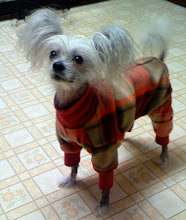
Louie held his own that night, and so in the morning my husband took him to UC Davis veterinary emergency where it was determined that he had not been vomiting blood but, in fact, had bloody diarrhea associated with colitis. That surprised me, as he’d been vomiting earlier that evening, but Louie always seems to be full of surprises.
One thing I had noticed earlier that day was that when I opened his can of prescription food, the food looked a little different. I started to suspect that we’d gotten a bad batch of food.
The vets at UC Davis didn’t seem to agree with this theory, saying that no one else had complained about the food. They wanted to keep him overnight, and they did some bloodwork and gave him some antibiotics, all the while feeding him the same food that I suspected had made him sick. The bloodwork came back with indications that both the pancreatitis and the lymphangiectasia were flaring up again. The vet at Davis returned him to me the following day, rather sheepishly admitting that they hadn’t helped him very much by keeping him there. He no longer had blood in his stool, but that was the only real improvement. I talked again with her about his food, and she suggested we try a home cooked diet along with some Tylosin to see if perhaps he would improve with a different food.
We’d had several similar overnights since his initial diagnosis (though this was the only one with colitis) and I sadly decided at this point that I was no longer able to take him back to Davis so frequently. It was expensive, stressful for both Louie and me, and by now we never seemed to learn anything particularly helpful or new from all the expensive testing that I couldn’t ascertain on my own through observation. I had wiped out over $10,000—my entire savings--on his medical care already, and his prescription medications were costing close to $500.00 a month. I never wanted to make decisions about his health because of money, but it wasn’t clear how I could continue to sustain the expense of his care if I did not make some changes. I began to worry about what would happen if I could no longer afford to care for him.
I vowed then that we would only go back to pick up medications and food, or if we saw symptoms that were completely new to us. Louie would make it, or he would not, but throwing more money at the problem simply wasn’t useful anymore. I spoke with his vet and let her know that I felt I was reaching a financial limit with his care and asked if I could trust her to advise us over the phone if we had repeated bouts of similar symptoms, and she agreed. She had already talked me out of euthanizing him once, early on, when I was at my wit’s end with a particularly bad relapse, and watching him suffer was getting the better of me. If she thought he had any chance of making it through to a decent quality of life again, I would do what we needed to do.
We had the nutritionists at UC Davis formulate a diet for us, and I began cooking for him at home. The main ingredients in this diet were white rice, chicken and a supplement. I fed variations of this diet for several months, but it never really agreed with him. His stool was loose and yellow, and he continued to seem weak. His legs became wobbly and he would tremble, especially at mealtime. He started shaking again after eating, and developed new lesions on his skin. It was also during this time that he began developing corneal lesions on his right eye and losing sight in both eyes, and so despite our financial situation we did, indeed, end up taking him back to Davis for yet another specialist to evaluate yet another new set of symptoms.
I had thought that perhaps the nutritionist’s diet as formulated was still too high in fat for him, so I’d been attempting to get more and more fat out of it, but clearly nothing was working. In addition to the eye problems, he developed blisters on his skin, which I thought might be due to the lack of fat in his diet.
In a fit of frustrated desperation I went rummaging in the cupboard one night and found an old, dented can of the prescription food that I’d apparently set aside, thinking it might be too hard to open. I got it open and began feeding this again, adding a small amount of probiotic this time. To my surprise and delight, he rapidly began to improve. I bought more. Whatever it was that had been the problem with the prescription food seemed to have been resolved and, once again, we were on our way. It was now late January, 2009, almost a year since that first bout with pancreatitis that had preceded all of our troubles.








